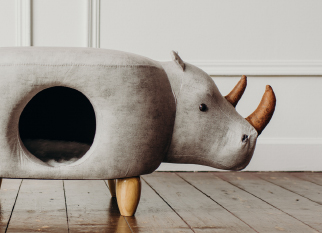How can Leather Fabric optimize the supply chain and reduce costs by improving production processes?
1. Introducing automated and intelligent production equipment
In the traditional Leather Fabric manufacturing process, a large number of production processes rely on manual operations, such as cutting, sewing, grinding, polishing, etc. This method is not only inefficient, but also prone to material waste and unstable quality due to manual errors. Therefore, the introduction of automated production equipment has become the key to optimizing the production process.
(1) Intelligent cutting equipment
The use of laser cutting machines or CNC cutting machines can achieve high-precision cutting, reduce manual operation errors, and improve leather utilization.
The automated cutting system can intelligently layout and cut according to the irregular shape of the leather, minimizing the waste of scraps.
By optimizing layout and improving material utilization through computer-aided design (CAD), the consumption of raw materials can be reduced by 10%-20%.
(2) Automated sewing and processing
Automatic sewing machines and robotic sewing systems can increase production speed, reduce human errors, and improve the consistency of finished products.
The use of intelligent punching machines, embossing machines, and splicing machines can improve efficiency while reducing labor costs. They are suitable for high-end leather goods, automotive interiors and other fields.
(3) Intelligent quality inspection system
Traditional quality inspection mainly relies on manual visual inspection, which is prone to omissions or inconsistencies. The AI visual inspection system can automatically identify defects such as scratches, color differences, uneven thickness, etc., improving inspection accuracy and production efficiency.
Combined with RFID (radio frequency identification) or barcode tracking systems, real-time tracking of the production status and quality information of each leather can be achieved, improving the transparency of supply chain management.
2. Production process optimization and lean management
In addition to introducing advanced equipment, optimizing production processes can also improve efficiency and reduce costs.
(1) Lean Production
Reduce waste: By analyzing the waste links in the production process (such as inventory backlogs, unnecessary transportation, processing redundancy, etc.), optimize process arrangements and improve production efficiency.
Standardized operations: Formulate detailed production standards and operating procedures to reduce human errors and improve product consistency.
(2) Modular production
Modular design is used to split different parts of leather products into standardized components and then assemble them to improve production flexibility.
This method is particularly suitable for products such as car seats, furniture leather, and luggage leather goods. It can reduce the cost of customized production and improve capacity utilization.
(3) Digital production management
The MES (Manufacturing Execution System) is used to monitor production data in real time, including equipment status, order progress, inventory status, etc., to improve decision-making efficiency.
The Internet of Things (IoT) technology is used to connect devices to achieve remote monitoring and predictive maintenance, reducing downtime caused by equipment failure.
3. Improve material utilization and reduce waste
The cost of leather raw materials is high, so improving material utilization is an important means to reduce costs.
(1) Optimize leather cutting methods
Use intelligent typesetting software and AI algorithms to automatically optimize cutting plans to reduce waste of scraps.
For example, when making leather shoes, bags and other products, small pieces of leather can be used to make accessories to improve material utilization.
(2) Recycling and reuse of scraps
Waste generated during the leather production process can be recycled and used to make recycled leather or other leather products.
For example, scraps can be crushed and combined with PU (polyurethane) to make environmentally friendly recycled leather, which is widely used in footwear, furniture and other fields.
(3) Thin and lightweight design
Nano coating or high-density textile base layer is used to replace traditional heavy leather to reduce material costs while improving breathability and comfort.
In application scenarios such as automotive interiors and airline seats, lightweight design can effectively reduce fuel consumption and improve environmental performance.
4. Use environmentally friendly tanning technology to reduce chemical costs
The traditional chrome tanning process has pollution problems and high chemical costs. Many leather manufacturers are looking for more environmentally friendly alternatives.
(1) Vegetable tanned leather
Vegetable tanned leather is processed using natural tannins (such as oak and chestnut extracts), which reduces the use of chemical agents and reduces processing costs.
It is suitable for the high-end leather goods and luxury goods market, has better environmental properties, and complies with European and American environmental regulations. (2) Water-based tanning
Using solvent-free water-based coatings can reduce the use of organic solvents, reduce environmental pollution, and improve the durability of leather.
This method is suitable for products such as automotive interiors, furniture leather, and sports shoes, and can meet global environmental regulations.
(3) Chrome-free tanning
Using chrome-free alternatives, such as aldehyde tanning or organic acid tanning, can reduce chrome pollution and improve the recyclability of leather.
It is suitable for markets with strict environmental requirements, such as Europe and North America.
5. Conclusion: How improving production processes can help the leather industry reduce costs and increase efficiency
Through the above measures, leather manufacturers can significantly reduce production costs and improve supply chain efficiency while ensuring product quality. The following are key optimization points:
Introducing automated equipment to improve production efficiency and reduce labor costs.
Optimizing production processes, reducing waste through lean management, and improving capacity utilization.
Increasing material utilization, using smart layout and waste recycling to improve cost-effectiveness.
Environmentally friendly tanning technology reduces the use of chemicals, reduces pollution, and meets international environmental standards.



















